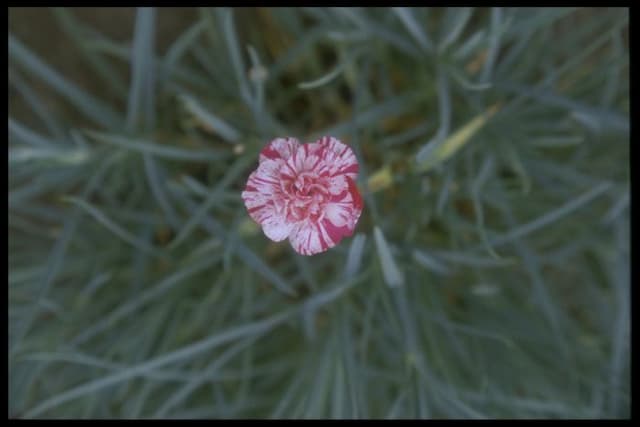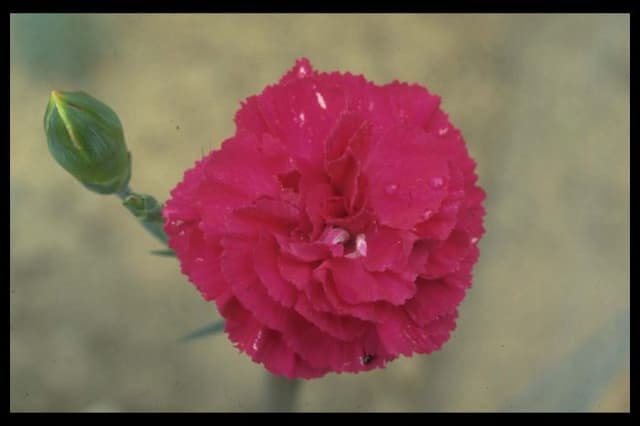Pink Dianthus 'Uncle Teddy' (b)

ABOUT
Dianthus 'Uncle Teddy' is a charming perennial plant known for its attractive, dense tufts of narrow, green leaves. The foliage provides a lush backdrop for the standout feature of this plant: the flowers. These blooms are sweetly fragrant and often emerge in a profusion of color that can range from shades of pink to whites or sometimes reds, each blossom typically sporting five petals with frilly or serrated edges that add to their ornamental appeal. The flowers are held above the foliage on sturdy stems and tend to bloom profusely during late spring through early summer, and may rebloom again if the spent flowers are removed. The overall impression of Dianthus 'Uncle Teddy' is one of delicate charm and colorful beauty, making it a favored choice for gardens and landscape displays where a splash of color and scent is desired.
About this plant
 Names
NamesFamily
Caryophyllaceae.
Synonyms
Carnation, Pink, Sweet William.
Common names
Dianthus 'Uncle Teddy'
 Toxicity
ToxicityTo humans
The common name for Dianthus 'Uncle Teddy' is Carnation. Carnations are not considered toxic to humans. However, ingestion of any plant material can potentially cause mild gastrointestinal discomfort due to the presence of saponins. Symptoms could include nausea, vomiting, or diarrhea if consumed in large quantities.
To pets
Carnation, the common name for Dianthus 'Uncle Teddy', is generally considered non-toxic to pets. However, some animals may experience mild gastrointestinal upset if they consume parts of the plant, with symptoms like vomiting or diarrhea. This would generally occur only if a large amount was ingested.
 Characteristics
CharacteristicsLife cycle
Perennials
Foliage type
Evergreen
Color of leaves
Blue-green
Flower color
Pink
Height
1-2 feet (30-60 cm)
Spread
1-2 feet (30-60 cm)
Plant type
Herb
Hardiness zones
5
Native area
Europe
Benefits
 General Benefits
General Benefits- Attractive Flowers: Dianthus 'Uncle Teddy' produces bright, eye-catching flowers that add a splash of color to gardens and landscapes.
- Drought Tolerance: Once established, they are quite drought-tolerant, making them suitable for xeriscaping or regions with low water availability.
- Low Maintenance: They require minimal care beyond the occasional watering and deadheading to promote further blooming.
- Cold Hardiness: This plant can withstand cold temperatures, making it a good choice for cooler climates.
- Long Blooming Period: 'Uncle Teddy' has a lengthy blooming season, offering colors throughout spring and summer.
- Attracts Pollinators: The flowers attract butterflies, bees, and other beneficial pollinators, supporting local ecosystems.
- Fragrance: The blooms of Dianthus often have a delightful fragrance, which can add another layer of enjoyment to the garden setting.
- Versatility: These plants are versatile and can be used in beds, borders, containers, and as edging plants, providing numerous design options.
- Evergreen Foliage: Many Dianthus varieties, including 'Uncle Teddy', have evergreen foliage, providing year-round interest.
 Medical Properties
Medical PropertiesThis plant is not used for medical purposes.
 Air-purifying Qualities
Air-purifying QualitiesThis plant is not specifically known for air purifying qualities.
 Other Uses
Other Uses- As a natural dye: The petals of the Dianthus can be used to create a natural dye for fabrics and yarns, offering hues of pink depending on the mordant used.
- In potpourri: The flowers of the Dianthus have a pleasant fragrance and can be dried to be included in potpourri mixes.
- Edible flowers: The blooms of the Dianthus are edible and can be used in salads, as cake decorations, or to add color and a hint of spice to various dishes.
- Craft projects: The vibrant petals can be used in scrapbooking, card making, or other paper crafts for a natural touch.
- As a bookmark: Dried Dianthus flowers can be laminated or pressed within the pages of a book, serving as a delicate and aromatic bookmark.
- In homemade soaps: The petals can be incorporated into homemade soap recipes for exfoliation, color, and fragrance.
- Floral water: Distilling Dianthus petals to create floral water can be used for cosmetic purposes or as a light perfume.
- Greeting cards: Fresh or dried petals can be used on greeting cards for a 3D effect and a subtle fragrance.
- Candle making: Dianthus petals can be embedded into candles for decoration and to lightly scent the wax as it burns.
- Flower confetti: Dried petals can be used as biodegradable confetti for weddings or celebrations.
Interesting Facts
 Feng Shui
Feng ShuiThe plant Carnation is not used in Feng Shui practice.
 Zodiac Sign Compitability
Zodiac Sign CompitabilityThe plant Carnation is not used in astrology practice.
 Plant Symbolism
Plant Symbolism- Pink (Common name of Dianthus 'Uncle Teddy'): Pinks generally symbolize affection, love, and admiration. The distinctively patterned petals may represent intricate emotions and express a variety of messages depending on their color and context.
- Devotion: The longevity of the Dianthus flower, with blooms that last through the early spring until fall, symbolizes a commitment that stands the test of time.
- Chivalry: The Dianthus was historically associated with knights and nobility; hence, giving this flower to someone could symbolize an act of honor or gallantry.
- Boldness: Dianthus flowers are known for their vibrant colors and a spicy fragrance similar to cinnamon or clove, reflecting a boldness and spiciness in life or character.
 Water
WaterCarnations require consistent moisture, but it is critical to avoid waterlogging. They should be watered deeply once or twice a week, depending on weather conditions and soil drainage. It's best to water in the morning to allow foliage time to dry and to provide ample moisture for the day ahead. A good rule is to provide about one inch of water per week, whether through rainfall or manual watering. In hotter, drier periods, you may need to increase watering frequency, but always check the soil before adding more water. Over-watering can lead to root rot and other issues, so ensure the soil dries out slightly between watering sessions.
 Light
LightCarnations thrive in full sun conditions, needing at least six hours of direct sunlight each day to flourish. The ideal location would be an east or south-facing garden spot where they receive plentiful morning and afternoon light. They can tolerate light shade, especially in hotter climates, but too much shade will reduce blooming and can lead to leggy plants.
 Temperature
TemperatureCarnations are fairly hardy and can tolerate a range of temperatures, but they grow best when daytime temperatures are between 60 and 70 degrees Fahrenheit and nighttime temperatures do not fall below 50 degrees Fahrenheit. They can survive minor frosts and temperatures momentarily dipping down to 40 degrees Fahrenheit, but prolonged exposure to cold below this or heat above 85 degrees Fahrenheit can damage the plant.
 Pruning
PruningPruning carnations is essential to encourage bushy growth and more blooms. Deadheading, or removing spent flowers, should be done consistently throughout the blooming season to promote continuous flowering. Perform light pruning in the spring to remove any dead or weak stems and to shape the plant. A more thorough pruning can be done after the first killing frost to prepare the plant for winter. This involves cutting back the stems to about one to two inches above the soil level.
 Cleaning
CleaningAs needed
 Soil
SoilCarnations, such as 'Uncle Teddy', require well-draining loamy soil with a neutral to slightly alkaline pH between 6.7 and 7.5. A mix of two parts potting soil, one part sand or perlite, and a handful of lime to adjust the pH is suitable.
 Repotting
RepottingCarnations, including the 'Uncle Teddy' variety, typically need repotting every one to two years to refresh the soil and accommodate root growth.
 Humidity & Misting
Humidity & MistingCarnations like 'Uncle Teddy' prefer average to low humidity levels, as high humidity can promote fungal diseases.
 Suitable locations
Suitable locationsIndoor
Place in bright indirect light with good air circulation.
Outdoor
Plant in full sun, well-draining soil, and water deeply.
Hardiness zone
3-9 USDA
 Life cycle
Life cyclePink 'Uncle Teddy' begins its life cycle when its seeds germinate in warm, well-drained soil, typically in spring or after the last frost. The seedlings develop into vegetative plants with a rosette of leaves at the base and sturdy stems. The vegetative stage is followed by the flowering stage, where the plant produces its characteristic pink flowers with ruffled edges, usually in late spring or early summer. After pollination, often by bees or butterflies, the flowers develop into seed capsules containing numerous small seeds. Once the seeds mature, they are dispersed to start a new generation, completing the reproductive cycle of the plant. The plant is perennial, so it may enter a period of dormancy in the winter before re-sprouting from its base the following spring.
 Propogation
PropogationPropogation time
Spring-Early Summer
Propogation: Dianthus 'Uncle Teddy', commonly known as Pinks, is most commonly propagated through cuttings. The ideal time for taking cuttings is late spring into early summer. To propagate by cuttings, you would select healthy, non-flowering stems and cut a 3 to 4 inch (approximately 7.5 to 10 centimeters) piece just below a leaf node. Strip the lower leaves off and dip the cut end into a rooting hormone powder to encourage growth. Then, insert the cutting into a well-draining potting mix, ensuring the soil is kept moist but not waterlogged. Place the container in indirect light and maintain a consistent temperature to facilitate rooting, which typically occurs in a few weeks. Once the cuttings have rooted and show signs of growth, they can be transplanted to their final location.






![Pink [Coconut Sundae]](/_next/image?url=https%3A%2F%2Fplants-admin.emdemapps.com%2Fimages%2Fplants%2F%2Fimages%2F604b5d09d4fd1.png&w=640&q=75)


